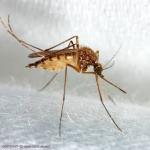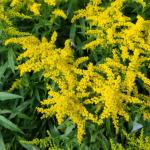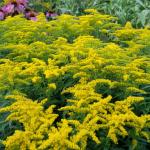A monthly e-newsletter from UMass Extension, published March to October, for home gardeners.
To read the articles in each section of the newsletter, click on the section headings below to expand the content:
Tips of the Month
September is the Month to.....
 Start your fall clean-up plan. Diseased materials should be removed to avoid further spread and overwintering of pathogens. However, leaving some twigs, leaves, and branches can provide overwintering habitat for pollinators. Before clean-up begins, scout your yard for problem areas that should be thoroughly cleaned up as well as for areas where some debris left over the winter is acceptable. If you haven’t started one already, consider a compost pile for your fall cleanup. Just keep in mind to not include diseased materials.
Start your fall clean-up plan. Diseased materials should be removed to avoid further spread and overwintering of pathogens. However, leaving some twigs, leaves, and branches can provide overwintering habitat for pollinators. Before clean-up begins, scout your yard for problem areas that should be thoroughly cleaned up as well as for areas where some debris left over the winter is acceptable. If you haven’t started one already, consider a compost pile for your fall cleanup. Just keep in mind to not include diseased materials.
- Plant! Early to mid-fall is a good time to plant, since cooler temperatures help reduce plant stress. Adequate time after planting should be provided for root establishment prior to soil freezing.
- Keep watering when needed. September can be a dry month; if so, supplemental water can help plants to remain healthy and hydrated heading into winter. This is especially important for newly installed plants.
- Divide spring and summer blooming perennials such as iris. Stake tall fall blooming perennials such as asters.
- Plant spring blooming bulbs such as daffodils and crocus. Lift and store tender bulbs such as elephant ears and caladium.
- Start preparing your houseplants to move indoors. It is best to move houseplants inside when the temperatures are similar inside and out, or about a month before the heat is regularly on. Prior to moving plants inside, check for any pests and consider washing leaves with a diluted soap and water mixture. Plants should be moved inside prior to the first frost, which for western Massachusetts is late September, and for the Cape and the Islands, late October to early November.
- Make a sketch of your vegetable garden. Note where each crop was planted so that they can be rotated to a new spot next year. This helps to prevent the build up of diseases in a particular area.
- Be on the lookout for rose rosette. This disease can occur at any time of the year, but is frequently seen during fall growth. Also known as witches’-broom of rose.
- Harvest and dry or freeze herbs. Or pot up herbs and bring inside for continued use throughout the winter.
- Do a soil test. Fall is a great time to add organic matter to the soil. Fall applications provide amendments time to break down prior to plant growth in the spring. Amendments should be based on a soil test. For more info on getting a soil test, go to soiltest.umass.edu.
- Visit an orchard. Pick your own peaches, apples, or pears for a tasty pie or crisp!
- Aerate your lawn. Aeration helps to relieve soil compaction. Fall is also a good time for re-seeding lawns.
Amanda Bayer, Extension Assistant Professor of Sustianable Landscape Horticulture
Timely Topics
Peak Transmission of Mosquito-Borne Illness Extends Through September in Massachusetts
As we transition from hot, humid summer days to weather that evokes feelings of fall, we must remain on guard when it comes to protecting ourselves from biting insects, including mosquitoes. Mosquitoes usually remain active until hard frost.
An outbreak of Eastern Equine Encephalitis, also known as EEE, is occurring in Massachusetts in 2019, with the first human cases of EEE taking place in the state this year since 2013, as reported by state public health officials.
 The MA Department of Public Health states that EEE is a rare but serious and potentially fatal disease that can affect people of all ages. EEE has occurred sporadically in Massachusetts, with the most recent outbreak years occurring from 2004-2006 and 2010-2012. (The MA Department of Public Health states that since EEE was first identified in Massachusetts in 1938, fewer than 100 cases have been reported. Over 60% of those cases have been from Plymouth and Norfolk Counties.)
The MA Department of Public Health states that EEE is a rare but serious and potentially fatal disease that can affect people of all ages. EEE has occurred sporadically in Massachusetts, with the most recent outbreak years occurring from 2004-2006 and 2010-2012. (The MA Department of Public Health states that since EEE was first identified in Massachusetts in 1938, fewer than 100 cases have been reported. Over 60% of those cases have been from Plymouth and Norfolk Counties.)
What is EEE? Eastern Equine Encephalitis is a rare disease caused by a virus that is spread by mosquito vectors. It is one of a group of mosquito-borne viruses that can cause encephalitis (inflammation of the brain). “There is no treatment for EEE. In Massachusetts, about half of the people identified with EEE died from the infection. People who survive this disease will often be permanently disabled. Few people recover completely.” Source: https://www.mass.gov/service-details/eee-eastern-equine-encephalitis
Two types of infection are reported by the Centers for Disease Control and Prevention (CDC): systemic or encephalitic. Across the United States, according to the CDC, 5-10 cases of EEE are reported annually. This virus is transmitted through the bite of an infected mosquito. (Transmission does not occur from person to person.) For more information about symptoms and treatment, visit: https://www.cdc.gov/easternequineencephalitis/tech/symptoms.html
The MA Department of Public Health has announced a fourth human case of EEE in Massachusetts in 2019. Laboratory testing has confirmed EEE in a male over the age of 60 in southern Plymouth County, a male between the ages of 19-30 in eastern Worcester County, a male over the age of 60 in northern Franklin County, and a female over the age of 50 in southern Bristol County. Of these cases, one individual has reportedly passed away.
At the time this article was written, EEE virus activity has been detected in Barnstable, Bristol, Essex, Franklin, Hampden, Hampshire, Middlesex, Norfolk, Plymouth, and Worcester counties. As of 8/29/19, the MA Department of Public Health categorizes at least 27 communities as “Critical Risk”; 37 communities as “High Risk”; and 126 communities as “Moderate Risk”. For a map of these locations, visit: http://www.mosquitoresults.com/ .
As a result, aerial applications of an insecticide have been made in certain areas of Massachusetts. While aerial spraying is expected to reduce the number of mosquitoes in these areas that can spread EEE, aerial applications (which target adult mosquitoes, not developing mosquito larvae), do not eliminate risk. For more information about aerial spraying for mosquitoes in these areas, visit: https://www.mass.gov/guides/aerial-mosquito-control-summer-2019 . This web page includes information about the pesticide product used in aerial spraying activities and the product’s active ingredients, as well as “Frequently Asked Questions” many may have about aerial spraying in Massachusetts.
Who is at risk? Anyone in an area where the virus is circulating can become infected with EEE; however, the CDC states that the risk is highest for people who live in, or visit, woodland habitats, and those who work outside (arborists, gardeners, golf course personnel, land managers, landscapers, and other landscape practitioners) or participate in outdoor recreational activities (campers, golfers, hikers, sports participants, etc.) due to greater exposure to potentially infected mosquitoes.
How can people minimize risk? Prevention of mosquito bites is vital. For areas in Massachusetts, even where aerial spraying has occurred, the MA Department of Public Health urges residents to continue to protect themselves from mosquito bites by taking various preventative measures. These include:
- Staying indoors during peak mosquito hours (between dusk and dawn) – the MA Department of Public Health provides recommended cancellation times for outdoor activities in high risk areas here: https://www.mass.gov/guides/aerial-mosquito-control-summer-2019 .
- Applying CDC recommended insect repellent when outdoors – those containing DEET, picaridin, IR3535, or oil of lemon eucalyptus have been recommended by the Centers for Disease Control for use on exposed skin/clothing when used as instructed on the label. Permethrin has also been recommended for use on clothing when used according to label instructions.
- A note about natural insect repellents (those not registered with the EPA): the effectiveness of non-EPA registered insect repellents, including some natural repellents, is not known. To protect yourself against mosquito-borne diseases, the CDC recommends using an EPA-registered insect repellent.
- Wearing long sleeves and pants, weather permitting.
- Repairing screens on doors and windows.
How can mosquitoes be managed in our landscapes? The University of Maryland Extension provides an excellent overview of steps we can take to reduce mosquitoes around homes:
- Keep gutters clean and be sure they drain properly.
- Remove sources of standing water in yards, where mosquitoes can breed – drain water out of flower pots, plant saucers, tarps, buckets, barrels, tires, bird baths, trash containers, toys, child’s wading pools, and other various containers and objects that can trap water.
- Use Bacillus thuringiensis israelensis (Bti) (Mosquito Dunks®, Mosquito Bits®, or similar products) according to label instructions to reduce breeding larvae. Bti is a naturally occurring bacterium found in soils, which targets and kills mosquito larvae, posing no threat to humans, pets, honeybees, etc. Bti may be purchased at businesses that sell garden products. For more information about Bti, visit: https://www.epa.gov/mosquitocontrol/bti-mosquito-control .
For more information about mosquito management in landscapes, go to https://extension.umd.edu/hgic/topics/controlling-mosquitoes.
For more information about EEE and managing mosquitoes, visit:
MA Department of Public Health:
- https://www.mass.gov/service-details/eee-eastern-equine-encephalitis
- https://www.mass.gov/news/state-public-health-officials-announce-first-human-case-of-eee-in-the-commonwealth
- https://www.mass.gov/news/state-public-health-officials-announce-second-human-case-of-eee-in-the-commonwealth
- https://www.mass.gov/news/state-public-health-officials-announce-third-human-case-of-eee-in-the-commonwealth
- https://www.mass.gov/news/state-public-health-officials-announce-fourth-human-case-of-eee-in-the-commonwealth
- https://www.mass.gov/mosquito-borne-diseases
- https://www.mass.gov/guides/aerial-mosquito-control-summer-2019
- http://www.mosquitoresults.com
Centers for Disease Control and Prevention:
University of Maryland Extension:
Colorado State University Extension:
Tawny Simisky, UMass Extension Entomologist
News for Gardeners
Fall Perennial Border Stalwarts
As summer draws to a close, your flower beds needn’t follow suit. Hardy mums are often what come to mind for an instant fall garden refresh. While mums are undoubtedly vibrant, don’t overlook the veritable cornucopia of perennials that can be sourced to provide a display of autumnal color. If you find that your ornamental beds are looking a bit lackluster this time of year, read on for just a few of the options available to bring them back to life.
 Sedum ‘Autumn Joy’ (as it’s commonly known, but actually classified as Hylotelephium ‘Herbstfreude’, zones 3-8) is arguably as ubiquitous as hardy mums for fall color, and for good reason: it tolerates poor soils and drought, puts on a long-lived display of vivid pinkish-red flowers in clusters reminiscent of broccoli heads, and is a magnet for beneficial insects. It’s a well-behaved plant, forming clumps approximately 2 feet wide by 2 feet tall, and fends off deer and rabbit attacks admirably. But venture beyond ‘Autumn Joy.’ Some of the newer varieties to drool over include ‘Autumn Fire,’ a longer-lasting version of ‘Autumn Joy,’ and ‘Autumn Charm,’ sporting cream and light green variegated leaves and darker red flowers. Also worthy are cultivars of the related species Sedum spectabile (actually Hylotelephium spectabile, zones 3-8), such as ‘Brilliant,’ 18 inches to 2 feet tall with greyish foliage and medium pink flowers or ‘Neon,’ slightly shorter with neon pink blooms.
Sedum ‘Autumn Joy’ (as it’s commonly known, but actually classified as Hylotelephium ‘Herbstfreude’, zones 3-8) is arguably as ubiquitous as hardy mums for fall color, and for good reason: it tolerates poor soils and drought, puts on a long-lived display of vivid pinkish-red flowers in clusters reminiscent of broccoli heads, and is a magnet for beneficial insects. It’s a well-behaved plant, forming clumps approximately 2 feet wide by 2 feet tall, and fends off deer and rabbit attacks admirably. But venture beyond ‘Autumn Joy.’ Some of the newer varieties to drool over include ‘Autumn Fire,’ a longer-lasting version of ‘Autumn Joy,’ and ‘Autumn Charm,’ sporting cream and light green variegated leaves and darker red flowers. Also worthy are cultivars of the related species Sedum spectabile (actually Hylotelephium spectabile, zones 3-8), such as ‘Brilliant,’ 18 inches to 2 feet tall with greyish foliage and medium pink flowers or ‘Neon,’ slightly shorter with neon pink blooms.
 Helenium (Helenium autumnale and hybrids, zones 3-8) is an outstanding, underused fall bloomer. Don’t be deterred by helenium’s other common name, sneezeweed; this daisy-like plant does not cause hayfever and is a colorful addition to the border—front or back, depending on the variety. Varieties range in height from 18 inches to over 5 feet with spreads of 2 to 3 feet, and colors from clear yellow to orange-yellow blends to bright red are available. Helenium prefers moist garden soil with ample amounts of organic matter, but excessive fertilization may cause it to become leggy and require staking; the plant attracts pollinators and is deer- and rabbit-resistant. Some of my favorite cultivars include ‘Moerheim Beauty,’ a 3 to 4-foot tall bronze-orange flowered award winner, MariachiTM ‘Salsa,’ a bright red flowered plant that grows only 18 to 20 inches tall, and ‘Butterpat,’ a large (4 to 5 feet) award-winning sneezeweed with cheery yellow blooms.
Helenium (Helenium autumnale and hybrids, zones 3-8) is an outstanding, underused fall bloomer. Don’t be deterred by helenium’s other common name, sneezeweed; this daisy-like plant does not cause hayfever and is a colorful addition to the border—front or back, depending on the variety. Varieties range in height from 18 inches to over 5 feet with spreads of 2 to 3 feet, and colors from clear yellow to orange-yellow blends to bright red are available. Helenium prefers moist garden soil with ample amounts of organic matter, but excessive fertilization may cause it to become leggy and require staking; the plant attracts pollinators and is deer- and rabbit-resistant. Some of my favorite cultivars include ‘Moerheim Beauty,’ a 3 to 4-foot tall bronze-orange flowered award winner, MariachiTM ‘Salsa,’ a bright red flowered plant that grows only 18 to 20 inches tall, and ‘Butterpat,’ a large (4 to 5 feet) award-winning sneezeweed with cheery yellow blooms.
 Aster might be the poster-child for fall in New England. The refined daisy-like flowers in various shades of purple abound at wood edges and in fields and meadows throughout the season. Further refinement can be found in cultivars of New England aster (Symphyotrichum novae-angliae, zones 4-8) suitable for fall borders. Grow New England aster in evenly moist garden soil amended with compost (though it is somewhat drought tolerant once established); as with sneezeweed, overly rich soil may cause spindly, floppy growth of aster. Also, like sneezeweed, New England aster earns high marks for sustaining minimal deer and rabbit damage and attracting pollinators. Reliable cultivars on the market include ‘Alma Pötschke,’ 3 to 4 feet tall with bright pink blooms, ‘Harrington’s Pink,’ up to 5 feet tall with light rose-pink flowers, and ‘Purple Dome,’ a smaller option growing up to 2 feet tall with striking deep violet blossoms. More recently, a series of New England asters has been introduced that is notable for both compact size (2 feet tall and wide) and abundance of flowers covering the plant. The series is called ‘Kickin’’ and comes in a variety of colors: ‘Kickin’ Carmine Red,’ ‘Kickin’ Purple,’ ‘Kickin’ Chiffon Pink,’ and ‘Kickin’ Lilac Blue’ among them. In addition to choosing New England asters for the garden, be sure to check out other aster possibilities, e.g. New York aster (Symphyotrichum novi-belgii, zones 4-8) and aromatic aster (Symphyotrichum oblongifolium, zones 4-8).
Aster might be the poster-child for fall in New England. The refined daisy-like flowers in various shades of purple abound at wood edges and in fields and meadows throughout the season. Further refinement can be found in cultivars of New England aster (Symphyotrichum novae-angliae, zones 4-8) suitable for fall borders. Grow New England aster in evenly moist garden soil amended with compost (though it is somewhat drought tolerant once established); as with sneezeweed, overly rich soil may cause spindly, floppy growth of aster. Also, like sneezeweed, New England aster earns high marks for sustaining minimal deer and rabbit damage and attracting pollinators. Reliable cultivars on the market include ‘Alma Pötschke,’ 3 to 4 feet tall with bright pink blooms, ‘Harrington’s Pink,’ up to 5 feet tall with light rose-pink flowers, and ‘Purple Dome,’ a smaller option growing up to 2 feet tall with striking deep violet blossoms. More recently, a series of New England asters has been introduced that is notable for both compact size (2 feet tall and wide) and abundance of flowers covering the plant. The series is called ‘Kickin’’ and comes in a variety of colors: ‘Kickin’ Carmine Red,’ ‘Kickin’ Purple,’ ‘Kickin’ Chiffon Pink,’ and ‘Kickin’ Lilac Blue’ among them. In addition to choosing New England asters for the garden, be sure to check out other aster possibilities, e.g. New York aster (Symphyotrichum novi-belgii, zones 4-8) and aromatic aster (Symphyotrichum oblongifolium, zones 4-8).
 Anemone (Anemone x hybrida, zones 4-8) ‘Honorine Jobert’ was the Perennial Plant Association’s Plant of the Year in 2016, and with good reason. It is an eye-catching plant in lightly or moderately shaded garden beds, with its 2- to 3-inch pure white flowers with yellow centers, each perched on a 3- to 4-foot stem above a 12-inch tall base of dark green foliage. It prefers moist soil in a location protected from wind, and will thrive in full sun as well as shade—as long as these conditions are met. Once established, ‘Honorine Jobert’ may spread via rhizomes to form an attractive mass planting. The plant is deer-resistant and has few pest or disease concerns. ‘Honorine Jobert’ is in good company: some of the many other fall-blooming anemones deserving attention include ‘Max Vogel,’ a pale pink variety and ‘September Charm,’ with pink-purple flowers as well as Japanese anemone (Anemone hupehensis var. japonica, zones 5-8) ‘Prinz Heinrich’ (or ‘Prince Henry’), 2 to 3 feet tall with double whirls of blooms in deep pink. All three are well-established cultivars that have proven themselves over time. More recent fall anemone introductions are the Pretty Lady series (e.g. ‘Pretty Lady Diana,’ ‘Pretty Lady Emily’) and the Fantasy series (e.g. ‘Cinderella,’ ‘Little Red Riding Hood’), which consist of more compact plants in a variety of colors (both series zones 5-8).
Anemone (Anemone x hybrida, zones 4-8) ‘Honorine Jobert’ was the Perennial Plant Association’s Plant of the Year in 2016, and with good reason. It is an eye-catching plant in lightly or moderately shaded garden beds, with its 2- to 3-inch pure white flowers with yellow centers, each perched on a 3- to 4-foot stem above a 12-inch tall base of dark green foliage. It prefers moist soil in a location protected from wind, and will thrive in full sun as well as shade—as long as these conditions are met. Once established, ‘Honorine Jobert’ may spread via rhizomes to form an attractive mass planting. The plant is deer-resistant and has few pest or disease concerns. ‘Honorine Jobert’ is in good company: some of the many other fall-blooming anemones deserving attention include ‘Max Vogel,’ a pale pink variety and ‘September Charm,’ with pink-purple flowers as well as Japanese anemone (Anemone hupehensis var. japonica, zones 5-8) ‘Prinz Heinrich’ (or ‘Prince Henry’), 2 to 3 feet tall with double whirls of blooms in deep pink. All three are well-established cultivars that have proven themselves over time. More recent fall anemone introductions are the Pretty Lady series (e.g. ‘Pretty Lady Diana,’ ‘Pretty Lady Emily’) and the Fantasy series (e.g. ‘Cinderella,’ ‘Little Red Riding Hood’), which consist of more compact plants in a variety of colors (both series zones 5-8).
Jeninifer Kujawski, Horticulturist
Trouble Maker of the Month
Arborvitae Needle Blight: A Fast Growing Problem on a Landscape Staple
Arborvitae is routinely planted as a landscape ornamental. Planted in rows, arborvitae provides dense screening for privacy and border establishment. When planted as a specimen tree, they can be a center piece of any landscape. Due to their ubiquity on the landscape, arborvitae is often maligned as an unremarkable plant. Poor-quality nursery stock, bad planting techniques and aggressive pruning are an unfortunate consequence of their popularity, but this is true for any oft-planted landscape ornamental (e.g. boxwood).
Arborvitae and cedar are loosely used common names in commercial horticulture, but mostly refer to species of Thuja. Despite being referred to as cedar, members of genus Thuja are not true cedars; those belong to genus Cedrus. In our region, the most common species of arborvitae in commercial use is northern whitecedar (Thuja occidentalis). Two cultivars in particular are especially popular: ‘Nigra’ (Dark American) for its fast growth and dark green color that persists through the winter months and ‘Smargd’ (Emerald Green) for its tight, columnar habit that creates a dense screen. Western redcedar (T. plicata) and Green Giant arborvitae (T. plicata × standishii) are less common but still abundant on the landscape. Atlantic whitecedar (Chamaecyparis thyoides), meanwhile, is not routinely used because of its need for wet soils as an obligate wetland species.
One reason why species of Thuja are so popular in commercial horticulture is their resistance to insect and disease problems. Thuja species allocate significant resources to defense, and as a result, these trees can live for hundreds of years in their natural settings. The wood is very decay-resistant and is prized for building materials that are subjected to harsh climates. In addition, they can exhibit fast growth, resist drought well in most cases and have dense, overlapping branches of lustrous green needles. Despite all this, Thuja do suffer from pest and pathogen issues in the landscape. Over the past several years, arborvitae needle blight has become a significant threat to the long-term health of many trees in the landscape. Based on samples submitted to the UMass Plant Diagnostic Laboratory (UMPDL), the needle blight is primarily the result of infection by two fungi: Phyllosticta thujae and Pestalotiopsis.
 Little is currently known about the biology and ecology of Phyllosticta thujae. It was described as a new species in 1989 and is believed to occur only on species of Thuja. However, based on submissions to the UMPDL, this pathogen also appears to infect Leyland cypress (×Cupressocyparis leylandii), falsecypress (Chamaecyparis spp.) and juniper (Juniperus spp.). Plants infected by P. thujae typically have blighted needle tips and/or discolored (pale green to yellow) needles that may appear desiccated. Infections often initiate at the needle tip and progress towards the base. During wet and mild weather, black pads of fungal tissue (pycnidia) rupture through the epidermis on symptomatic needles to release large volumes of spores (conidia), which are then blown or splashed to nearby shoots to initiate new infections. Because arborvitae have dense canopies, especially those that are sheared, ideal conditions exist for development of the pathogen. Most infections likely establish during wet weather in the spring, when new needles are emerging and are not fully developed. Overall, many Phyllosticta species are poorly understood and are mostly treated as secondary pathogens on conifers. Aggressive pruning and winter injury are likely the two most important predisposing stresses that lead to infection. Since 2014, the UMPDL has received 69 samples positive for P. thujae from four host genera (Thuja, Chamaecyparis, ×Cupressocyparis and Juniperus).
Little is currently known about the biology and ecology of Phyllosticta thujae. It was described as a new species in 1989 and is believed to occur only on species of Thuja. However, based on submissions to the UMPDL, this pathogen also appears to infect Leyland cypress (×Cupressocyparis leylandii), falsecypress (Chamaecyparis spp.) and juniper (Juniperus spp.). Plants infected by P. thujae typically have blighted needle tips and/or discolored (pale green to yellow) needles that may appear desiccated. Infections often initiate at the needle tip and progress towards the base. During wet and mild weather, black pads of fungal tissue (pycnidia) rupture through the epidermis on symptomatic needles to release large volumes of spores (conidia), which are then blown or splashed to nearby shoots to initiate new infections. Because arborvitae have dense canopies, especially those that are sheared, ideal conditions exist for development of the pathogen. Most infections likely establish during wet weather in the spring, when new needles are emerging and are not fully developed. Overall, many Phyllosticta species are poorly understood and are mostly treated as secondary pathogens on conifers. Aggressive pruning and winter injury are likely the two most important predisposing stresses that lead to infection. Since 2014, the UMPDL has received 69 samples positive for P. thujae from four host genera (Thuja, Chamaecyparis, ×Cupressocyparis and Juniperus).
Pestalotiopsis (pronounced Pesta-low-she-opsis) is a common pathogen on coniferous trees and shrubs in landscape settings, causing shoot and branch dieback on numerous species and varieties of Thuja, Chamaecyparis, Cryptomeria and Juniperus. The fungus invades the plant at the tips of new shoots, or can utilize pruning wounds as a source of entry. Once established, it causes browning and dieback that can eventually kill small branches. Overall, Pestalotiopsis can likely be described as more aggressive in comparison to Phyllosticta because of its ability to attack stems and small branches. Phyllosticta, meanwhile, is primarily restricted to the needles. Pestalotiopsis is opportunistic and attacks weakened plants pre-disposed by drought, insect feeding, mechanical damage and establishment stress. The fungus is a known endophyte, meaning that it can live dormant within the plant without causing disease, an adaptation that allows it to readily overwinter in asymptomatic plant tissues. Pestalotiopsis produces small pads of fungal tissue underneath the epidermis, and when moisture is abundant the pads ruptures through, producing a long black mass of spores. During wet weather, spores are blown and splashed onto healthy, nearby plant parts, initiating new infection centers.
The best course of action for management of any needle and shoot blight pathogen is to prune and discard as many infected plant parts as much as possible. Dead shoots and needles harbor the fungal pathogens and allow them to overwinter in the tree canopy. When they sporulate from the dead tissue the following year, the spores are in very close proximity to newly developing and susceptible tissues. On well-established mature trees, this level of pruning can be a daunting task, but a necessary one if the disease is to be successfully controlled. In addition, removal of discarded needles around the tree is also helpful. However, it is important to keep in mind that spores travel long distances and both Phyllosticta and Pestalotiopsis are widespread in the environment. Avoid pruning during wet weather, as this is the time period when the fungus is most actively producing and disseminating spores. Also, watering with sprinklers or sprayers that wets the foliage, leaving free moisture to linger on the needles can facilitate spore production and germination. Drip irrigation or hand-watering of newly planted trees is preferable.
Chemical management may be warranted in certain cases, such as when trees are recently planted and are undergoing transplant shock. Fungicides labeled for use on ornamentals in Massachusetts that may have utility against both pathogens include: chlorothalonil, copper hydroxide, copper salts of fatty and rosin acids, thiophanate-methyl and mancozeb. Fungicides should be used as a preventative measure to limit infections on the current year's growth in the spring. Chemicals will have a reduced impact on fungal pathogens later in the growing season. Proper spacing and planting techniques can alleviate some of the predisposing stresses that allow infections to establish on trees suffering from transplant shock. Arborvitae can tolerate some shade, preferably in the afternoon, but prefer full sun to thrive. Therefore, proper placement of arborvitae in the landscape is critical in avoiding a disease outbreak.
Nicholas J. Brazee, Ph.D., UMass Extension Plant Pathologist
Plant of the Month
Solidago spp. - Goldenrod
Goldenrod often gets a bad rap, being the target of criticism for hay fever or allergies caused not by goldenrod, but by ragweed. Goldenrod is bee and insect pollinated and therefore does not create the large amounts of airborne pollen necessary to cause allergies. Besides being mislabeled as causing allergies, goldenrod’s nearly ubiquitous presence in the landscape makes it an often-overlooked plant.
Solidago is a genus in the Asteraceae family. The flowers of goldenrod don’t look like the typical daisy-like flowers of the Asteraceae from afar, but up-close the ray and disk florets that are characteristic of the family are visible. The genus contains about 100 species, most of which are native to North America. There are about two dozen species in Massachusetts. Goldenrod can be found in a number of diverse habitats including meadows, roadsides, woodlands, swamps and shorelines. When choosing a goldenrod for the landscape, its native habitat should be considered to determine whether it is likely to thrive.
Not all goldenrods are good choices for the garden. Some species, like Canadian goldenrod (Solidago canadensis) and tall goldenrod (Solidago altissima), are tall and aggressive rhizomatous species; depending on the situation, these maybe referred to as weeds. There are, however, a number of species and cultivars that do make good landscape plants. Goldenrods that make good garden plants tend to be shorter, sturdier, have dense flowers, and are able to thrive in typical garden soils.
Goldenrod has many uses in the landscape with its bright yellow/gold flowers that can easily draw the eye. It can be used in mass plantings or as a focal point in a traditional perennial border. Goldenrod mixed with asters, chrysanthemums or sedums can make a beautiful fall garden or display. Goldenrod is also a great plant for pollinator gardens, attracting not only bees but a large variety of other insects to its late season pollen and nectar resources.
Species and Cultivars
- Solidago rigida – Stiff goldenrod, grows 3-5’ tall and has dense flat heads of bright yellow flowers. It does have a slowly spreading rhizomatous habit.
- Solidago caesia – Blue stemmed goldenrod is an unaggressive species which spreads slowly, reaching only 2-3’. Sulfur yellow flowers bloom all along the axils and in terminal clusters; not as floriferous as cultivars.
- Solidago rugosa ‘Fireworks’ - Fireworks is an improved selection of Solidago rugosa, growing only 3-4’ tall in a slowly spreading clump, and should be divide approximately every three years. The yellow flowers burst from the plant, typically starting in late August, and are full for most of the month of September.
- Solidago sphacelate ‘Golden Fleece’ – Golden Fleece is a compact cultivar with golden yellow flowers. The flowers bloom in plume-like panicles reaching 18-24”, slowly spreading, with heart shaped rosettes when not in bloom.
- Solidago ‘Goldkind’ aka Golden Baby – Goldkind is a compact golden yellow flowered goldenrod. The flowers bloom on horizontal panicles on 24-30” plants, slowly spreading with strong stems.
- Other cultivars worth exploring are ‘Gold Rush’, ‘Little Lemon’, ‘Solar Cascade’, and ‘Crown of Rays’.

 Russ Norton, Agriculture & Horticulture Extension Educator, Cape Cod Cooperative Extension
Russ Norton, Agriculture & Horticulture Extension Educator, Cape Cod Cooperative Extension
Additional Resources
Landscape Message - for detailed timely reports on growing conditions and pest activity
Home Lawn and Garden Resources
Find us on Facebook! www.facebook.com/UMassExtLandscape/
Follow us on Twitter for daily gardening tips and sunrise/sunset times. twitter.com/UMassGardenClip
Diagnostic Services
The UMass Extension Plant Diagnostic Lab provides, for a fee, woody plant and turf disease analysis, woody plant and turf insect identification, turfgrass identification, weed identification, and offers a report of pest management strategies that are research based, economically sound and environmentally appropriate for the situation. Accurate diagnosis for a turf or landscape problem can often eliminate or reduce the need for pesticide use. Sampling procedures, detailed submission instructions and a list of fees.
The UMass Soil and Plant Nutrient Testing Laboratory at the University of Massachusetts Amherst provides test results and recommendations that lead to the wise and economical use of soils and soil amendments. The Routine Soil Analysis fits the needs of most home gardeners. Sampling procedures plus the different tests offered and a list of fees.
Spread the Word!
Share this newsletter with a friend! New readers can subscribe to our Home Gardener E-Mail List.